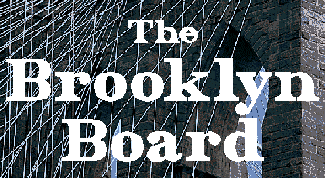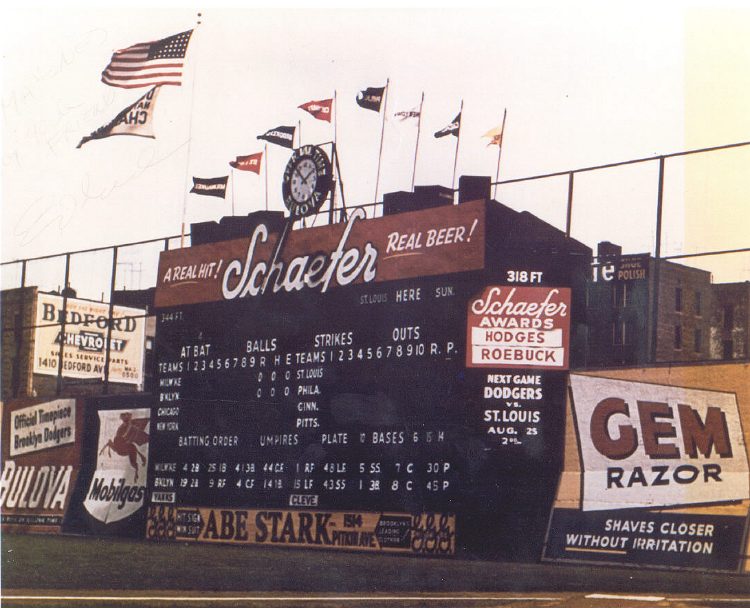
For displaced, misplaced, and nostalgic ex-Brooklynites |
|
The Cathedral S omeone once referred to Ebbets Field as Brooklyn's cathedral. It certainly was tome, growing up in the '40s and '50s. Though I was Jewish, I rarely went near a synagogue when I didn't have to. Despite having no formal religion in my life, I was not without faith. What I worshiped were the Dodgers. One of the commitments of Dodger devotion was brought home to me early in my conversion, during a game that the Dodgers were losing badly. Bored by the hopelessness of rooting for a victory that afternoon, my friend told me a silly joke and I laughed out loud into the glum quiet of a dispirited crowd. Suddenly, a booming adult voice redressed me. "Hey, kid, go be happy somewhere else!" he shouted, as all eyes turned toward me, burning themselves through my thin T-shirt. I shrank into my seat and silently vowed to take my faith more seriously in the future. Maybe it was loneliness, maybe narrow-mindedness, or maybe the world was just too complex for an only child whose parents had just divorced, dividing my life between two homes. In any case, once I discovered the Dodgers and Ebbets Field, and vowed to support them unquestioningly, my team became the measure of my happiness. Everything was suddenly so simple. When they won, I felt good. When they lost, I felt bad. I lived in East Flatbush then, about two miles from Ebbets Field. Our kitchen window, always open on sultry summer nights, faced toward my newly found Mecca with no high-rises in between. On a clear night, I could see the lights from the field, glowing like a landed spacecraft -- or a cathedral open for holiday mass. Sometimes, the crowd noise cut through the still, hot air and a cheer echoed over the brake-squeals on Utica Avenue, signaling a good Dodger play or a win. 
What went on there involved the hearts and minds of the whole borough and transcended any ethnic and tribal differences. A Jewish Yankee fan was an alien to me, even if he was my uncle, cousin or neighbor. An Italian or Irish or Polish or Black Dodger rooter was a kindred spirit even if he was a stranger. And when Jackie Robinson joined the team, he was embraced as both our feared weapon against the rest of the league and our living civics lesson. Today's players are familiar media personalities, but aloof and distant persons who leave the ballpark surreptitiously in sleek cars, headed for their well-guarded, out–of–reach suburban enclaves. We saw our Dodgers on the subways they rode to their jobs just we did to ours. We walked past the homes they bought and the apartments they rented in our neighborhoods. We spotted them driving, strolling, shopping and sunning themselves on their stoops. Future hall of famer Gil Hodges lived just minutes from me. I often saw his wife and children or the hulking, craggily handsome star himself on the street, talking to his neighbors. Gino Cimoli, a star outfielder for at least one year in the late ‘50s, asked my friend's sister to babysit for him and his wife in their modest basement apartment. "Was he nice?" I asked her. "Very," she said. "And so handsome. Whew!" Once, a tree-tall and house-wide pitcher named Chris Van Cuyck boarded an IRT subway that I was on at Clark Street, on his way from the team hotel to the ballpark, where I too was headed. Carrying a duffel bag with his equipment, he seemed to have absolutely no sense of his own importance as he studied the Miss Rheingold sign over my head. I was too timid to approach him or signal my recognition. I vowed never to let that happen again. So when I looked up and saw Preacher Roe, who pitched a shutout against the Yankees in the 1949 World Series, preceding me through a subway turnstile after winning a mid-season game I attended, I called out to him. "Preacher," I said, "congratulations on your twelfth win." The stoop-shouldered Arkansas native raised his long, dour face and fixed his startlingly blue eyes on me, a wide-eyed 12-year-old. "Probably won't win another one this year," he drawled, before heading off to catch his train. The old pro had confided his insecurity to me. Or was it just false modesty? But the coup of my Dodger encounters came at Steeplechase Amusement Park in Coney Island, now the site of Keyspan Park and home to the current Brooklyn Cyclones. That's where, in the ill-fated season of 1951, I boldly drove my electric bumper car straight at one being driven by, of all people, the slick-fielding third-baseman Billy Cox, one of the "Boys of Summer." We collided with a shuddering thud, and his gaunt, pale old-man's face glowered then grinned at me from behind the cigarette dangling from his mouth. He promptly spun around and returned the favor, ramming my car head-on while I laughed giddily. "Did you see that?" I asked my best friend when the ride stopped. "See what?" he said. Though he was a member of the despised New York Giants, thus an enemy at our ballpark, all-star infielder Sid Gordon was my neighbor down the block when I was eight, living with my parents and grandparents near Rutland Road, and I had just begun to buy bubblegum with baseball trading cards inside the wrapper. My grandmother and Gordon's mother were confidantes who shopped at the same kosher butcher. "Er macht a guten leiben, my Sidney," Gordon's proud parent reported to her one day in Yiddish. He makes a good living from this ballplaying. Though it was not, apparently, enough to seduce him away from the familiar lower middle-class East New York neighborhood of butchers and postal clerks and dental mechanics, at least not during his early years in the majors. We regarded these exceptional athletes of Brooklyn as a somewhat more glamorous and successful version of all of us – making twice or perhaps three times as much as our fathers did. But certainly not millions like Rockefeller did then, and their successors do today. Moreover, because of the reserve clause, we found out later, they were indentured servants to the ballclub, which meant they were "ours": part of our community and our lives, year after year, unless the owners chose to trade or sell them, sending them off to become part of the fabric of another city. Those Dodgers, my Dodgers, who arrived in our midst in the mid-1940s, became the nucleus of a winning team for a decade, and survived pretty much intact until the team bled our hearts dry by leaving for the greener pastures of Los Angeles after the 1957 season, and Ebbets Field was turned into a housing project. Bound together in our daily lives, as well as in the special, exhilarating, hypnotic escape into a child's game with grownup dreams at stake, we - fans and players alike - understood that none of us was bigger than the team, the collective that bore the borough's name on its uniform. It was the religion we worshipped in a grassy cathedral on Bedford Avenue and Sullivan Place that sat 35,000 avid souls in its pews and sold kosher hotdogs in its aisles. |
Copyright ©2002-2025 SofTech Consulting, Chappaqua, New York, USA All Rights Reserved.